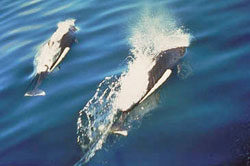Marine Mammal Viewing
Alaska’s marine mammals range from ocean-dwelling creatures, like whales, to those dependent on the oceans for food, like polar bears. To learn more about these animals and where to see them, click on the links below. Be sure to check back as we continue to build the website and add more animals to the list.
To reduce the potential for harm to marine mammals, familiarize yourself with the guidelines and regulations concerning marine mammal viewing.
- Beluga Whales
- Harbor Seals
- Humpback Whales
- Killer Whales
- Polar Bears
- Porpoises and Dolphins
- Sea Otters
Porpoises and Dolphins (Dall’s, Harbor and Pacific White-Sided)
Description

Dall’s porpoises are compact, muscular porpoises that rival killer whales as the fastest marine mammals in Alaska waters. Their black backs and white bellies and flanks resemble the markings of killer whales, but they are much smaller, averaging about six feet in length and weighing about 300 lbs (136 kg). They are fast swimmers and often generate a “rooster tail” spray that can be visible at long distances.
Dall’s porpoises typically travel in groups of 2 to 20 animals. They often “bow ride,” a behavior that is ideal for wildlife watching. The bow of a moving ship creates a pressure wave in the water, like the blast of wind that follows a passing truck. Porpoises and dolphins sidle up to a boat and swim just below the surface, riding in the pressure wave.
The similarly-sized Pacific white-sided dolphin, popular performers at oceanariums, often travel in multi-species herds of tens to several thousand animals. Like the Dall’s porpoise with whom they sometimes travel, they are fast swimmers and common bow riders but the Pacific white-sided dolphin will fully breach while swimming while the Dall’s porpoise rarely shows its flukes.
Harbor porpoises average about 120 lbs (55 kg), are gray or dark brown, and have noticeably smaller dorsal fins than those of Dall’s porpoises. They are often described as shy, but it is more appropriate to say they are indifferent to boats and human activities. They do not bow ride but are often spotted in calm seas when their rounded backs gently break the surface with rolling motions.
People often confuse porpoises with dolphins, but the two come from distinctly different families. Dolphins usually have beaks and more noticeable dorsal fins. Porpoises are usually smaller without the pronounced melons or beaks.
Habitat
The Dall’s porpoise is found in Alaska coastal waters as far north as the Bering Sea. Pacific white-sided porpoises travel as far north as Kodiak Island and are present in the Aleutians and Gulf of Alaska. Harbor porpoises may be found as far north as the Beaufort Sea in ice-free months.
Viewing
Look for Dall’s porpoises or Pacific white-sided dolphins any time you are traveling in Alaska’s coastal waters. They may be catching a free ride on the bow-wave of your boat. Harbor porpoises stay closer to shore in waters less than 300 ft deep.
